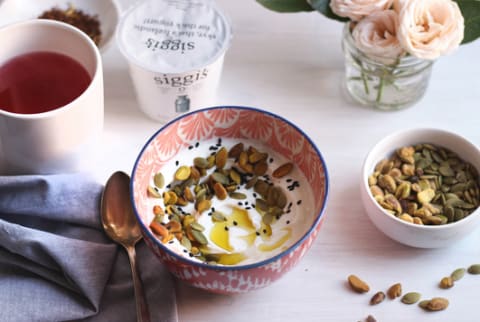Advertisement

Ah, the sweet tooth. Not even the fitness aficionados, doctors, and wellness experts we know are immune to its power! What sets the mentally clear and physically fit apart from the rest of us who easily succumb to sugar cravings? It's how you deal with them, of course.
Instead of muscling your way through your next craving, here are six ways to give in to it…in a healthy, low-sugar way.
1. Brew a naturally sweet-tasting or herbal tea.
You might feel hungry, but often all you need is a tall, hydrating beverage. Some of our favorite naturally sweet-tasting teas are raspberry, rooibos, licorice, and mint, all of which are caffeine-free.
2. Try infused water.
Infused water is one of those simple things that feels incredibly luxurious but is very easy to execute. Simply cut up your favorite fruits or veggies and let them marinate in a cold pitcher of H2O. For an extra-refreshing kick, use sparkling water as a base. Try some of our favorite combos:
- Strawberries + basil
- Oranges + lemons
- Cucumber
- Mint
3. Grab a lower-sugar version of your favorite sweet snack. (No stevia allowed!)
Instead of reaching for a pint of ice cream, make a healthy, gut-happy after-dinner concoction that has far less sugar.
Add 2 to 3 crushed squares of dark chocolate to siggi's 4% vanilla yogurt (which has less sugar than other brands). It's just the right amount of sweet, and the fat in both the chocolate and yogurt is incredibly satisfying. Not a fan of chocolate? Try making a savory treat by mixing olive oil and siggi's plain yogurt.
4. Go for a quick walk outside.
We underestimate the effects of a brisk walk, fresh air, and a dose of vitamin D. Many times, that's all you need to feel rejuvenated, energized, and ready to take on the rest of the day.
5. Take a break from work and read one of your favorite blogs or websites.
If you're someone who loves scrolling through Instagram, reading blogs, or scrolling other websites, use it to your advantage! Keep your perusing during the day to a minimum and save it for when you feel a craving coming on. This way, even your previously aimless web surfing can be put to good use.
6. Meditate.
Be present with your thoughts and go inside the craving. Ask yourself: What does your body really want? Many times it's something other than the craving: a hug, some rest (this is a big one!), a sweat session, a change of scenery, a listening ear, or a break from stress.
The next time a sugar craving strikes, try one of these techniques and observe how your mind and body react—you may find yourself feeling lighter and less erratic. The best part about finding the technique that resonates with you? Consistently implementing it may lead to fewer cravings over time. We'll raise a sparkling water to that!
